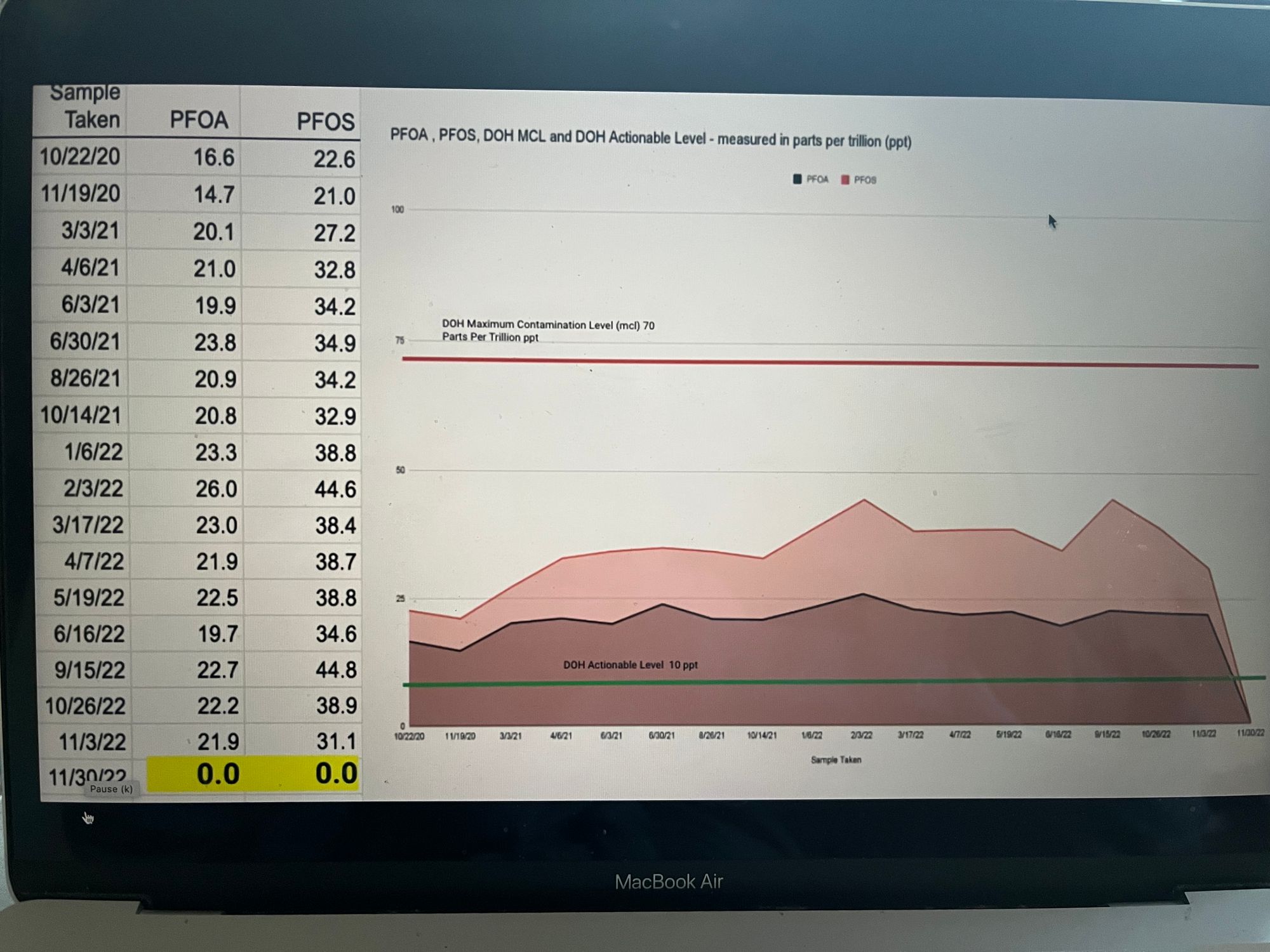Town Hall water is contaminated too!

Residents of Putnam Valley who are trying to gauge the extent of water contamination in their town have a new data point: the well at Town Hall!
On four occasions since September 2021, the level of perfluoroalkyl substances (PFAS) for the water at Town Hall has exceeded the maximum standard considered acceptable by New York State. The PFAS levels were similar to - or, in one case, higher than - those found at the nearby elementary school, which has spent the last two years putting in a carbon filtration system to address its water contamination problem.
Town Hall's test results were obtained from the Putnam County Department of Health by a concerned resident, Maggie Ploener, who sought them using the Freedom of Information Law. She did so following the January 23rd town board meeting at which Supervisor Jacqueline Annabi said the well water supplied to Town Hall had been tested for PFAS and the results "came out clean." According to Supervisor Annabi, "Our numbers were very, very low. 'Minute' is the exact description that was used."
Because of an old salt contamination problem with its well, Town Hall has been relying on bottled water for years. However, when a public water system is found to exceed the maximum level of 10 parts per trillion (ppt), the state's department of health requires jurisdictions to "notify health departments and the public of confirmed exceedances, and work with health departments on a timetable and plan to bring water systems into compliance."
At the January town meeting, Supervisor Annabi said that Town Hall had installed a filtration system, and cited that as the reason the town had joined a class action suit against chemical companies that produce products containing PFAS. However, in a subsequent email exchange, Annabi said that no filtration system had been installed. Former Town Supervisor Sam Oliverio said that if the lawsuit (filed during his administration) is successful, that can help cover the cost of future remediation.
There are differing views of the health risks from PFAS in drinking water. In a letter earlier this month to Supervisor Annabi, the county's health commissioner noted that PFAS is also found in many widely used household items. He added that 10ppt is well below levels known to cause health effects and that studies of PFAS have only focused on people with high levels of exposure.
New York State's maximum PFAS level of 10ppt (reduced in 2016 from 70ppt) is definitely among the most stringent in the country. However, the Environmental Protection Agency in June took an even more aggressive view: "The updated advisory levels, which are based on new science and consider lifetime exposure, indicate that some negative health effects may occur with concentrations of PFOA or PFOS in water that are near zero." Philippe Grandjean, an adjunct professor at Harvard's public health school, analyzed the new EPA guidance here, concluding: "Essentially, the EPA wants the limits to be as close as possible to zero as a growing body of research has shown how toxic these compounds are."
Interestingly, the lab that produced Town Hall's water tests cited the state's old 70 ppt limit as being within an acceptable range.
While the disparity in guidance from various jurisdictions is confusing, there are grounds for optimism. After the Putnam Valley Central School District found similar levels of PFAS to that of Town Hall in its elementary school water supply, the staff designed and installed a carbon filtration system. And it works! On February 9th, the district's director of operations and transportation, David Spittal, made a presentation to the school board showing that since that installation, PFAS levels in the school's water have fallen to zero.

"Putnam Valley is among the first in New York, and probably in the U.S., to address and eliminate PFAS," Spittal said. (The portion of his presentation focused on the school's water supply starts at the 53.45 minute mark on this video.)
In his presentation, Spittal acknowledged the differing views of PFAS safety standards. He said the school's water never exceeded the old 70 ppt standard and was therefore never considered unsafe to drink by the county's health department. But, citing the new, lower NYS standard, he said, "if it tests above 10ppt, we have to take action."
The news about contaminated water at Town Hall comes at a critical moment. Representatives from the county's Department of Health are coming to Town Hall on March 8th at 5pm to address residents' concerns and answer questions. The health commissioner's letter to Supervisor Annabi emphasized that the county has no obligation to monitor the water quality of private wells. Now that another public source of water is known to be contaminated, it may be harder to shirk responsibility for Putnam Valley's water woes.
With the town board saying that responsibility for water quality lies with the county, and the county emphasizing that it has no jurisdiction over private wells, which are the preponderance of Putnam Valley's water supply, it may be time to press for greater state involvement.
Additional resources are needed to identify the source of the contamination, launch remediation efforts, and offer support to homeowners with private wells that may now require filtration systems. According to the Department of Health website, New York has a Water Quality Rapid Response Team that "investigates water contamination reports and takes actions to remediate sources and reduce exposures. This team has been working to identify and address drinking water issues across the state, including testing public water and private wells around sites that are known sources of PFAS." Last year, after concerns about PFAS levels were raised in Mahopac, the state tested both private and public wells, provided bottle water, and installed treatment systems at 46 properties.
There is no shortage of funding available for this kind of support. In 2018, Governor Andrew Cuomo announced $200 million in grants to help communities address PFAS and other contaminants in drinking water supplies. And the Biden administration's infrastructure bill contained many millions of dollars more.
To date, water tests showing high PFAS levels have been found in a relatively small area of town, mostly along a section of Oscawana Lake Road.

Sample testing of other neighborhoods would help clarify if the problem is concentrated or widespread. If the former, that would certainly make mitigation efforts easier and less costly.